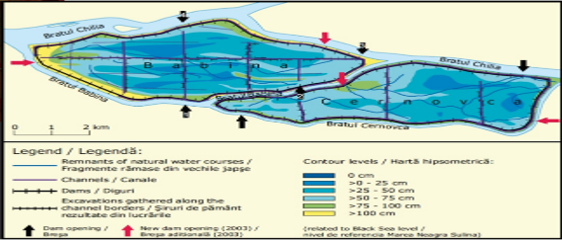Restoration in Babina and Cernovca Islets
Type 1 & 2 & 3 NBS


NBS info
| Country | Romania |
| River, water body | Danube Delta |
| Stage | ME |
| Size | Large |
| Geotype | Local |
| Innovative Solutions |
 |
 |
 |
Project summary
The objective of ecological restoration in Babina and Cernovca Islets was to restore the natural, site-specific hydrological, biogeochemical and ecological functions, to ensure the redevelopment of the ecosystem and its functions and thus to promote the development of site-specific habitats and their biodiversity. More-over, the redevelopment of the natural resources should enable the local populations to proceed to their sustainable, traditional use.
Best practices and references
Babina and Cernovca Islets was the first projects in the Danube Delta where new paths were stroke, away from an intensive, site-unspecific use back to near-natural structures, exemplar for nature conservation with and for man. It caused a change of mind and offered new incentives to restore further flood prone areas that had been altered by man, in the Danube Delta but also in Fore-Delta.
Environmental, socio-cultural, economic impacts
Restored natural functions allow the redevelopment of natural resources and values that are to the benefit of the local populations and of major importance for the local, regional and national economy. Given their natural functions and values that are traditionally used with regard to sustainability, the restored wetlands also satisfy fundamental socio-economic functions. For the local populations of the Delta the restoration of abandoned agricultural polders and fish ponds is a good option as compared to the abandoned polders that could not be used as planned. Fish resources play a decisive role as they constitute the local populations’ fundamentals of life. Reed cutting and use, especially with respect to the traditional construction methods in the Danube Delta, are among the major occupations of the people living in the Delta. Moreover, eco-tourism is of increasingly high importance. The landscape of the Delta, with its mosaic of waters and large reed areas, white willow gallery forests, dunes, the characteristic fauna of varying habitats and in particular its avifauna with large mixed, species rich colonies, benefits from a constantly growing interest. The areas comprised in the rehabilitation programme may thus also contribute to the development of an environmentally friendly sustainable eco-tourism.
Replication and scalability
The natural functions, once restored, develop certain existential values - natural and ideal resources - from which the local people can benefit, but also important for the local, regional and national economy. Through these traditionally and sustainably used resources and values, wetlands perform important socio-economic functions, providing the material basis for the local population. In this sense, ecological restoration is an alternative for abandoned agricultural and fish farms, which can no longer be used for the purpose for which they were intended.
Participation process
A management master plan that had been elaborated in a first phase for the Danube Delta Biosphere Reserve in 1992, comprised a number of areas to be restored, such as abandoned agricultural polders and unprofitable fish farms. Among these, the agricultural polders Babina (2100 ha) and Cemovca (1560 ha) were selected as pilot project areas for ecological restoration and were realized in a productive co-operation between the Danube Delta National Institute for Research and Development in Tulcea and the Institute for Floodplain Eco- logy of WWF Germany. Respective preparatory studies were conducted from 1992, allowing first restoration measures to be implemented already in 1994 in Polder Babina and in 1996 in Cernovca.
Lessons learnt
The prerequisite for starting a restoration process is a concise planning and implementation of the necessary measures to be taken. In the spring of 1994, the Babina polder located in the northeastern part of the Danube Delta and previously used for agricultural purposes, was reconnected to the flood regime of the Danube River. In doing so, fresh ground was not only broken in terms of restoring the drained wetlands of the Danube Delta. Rather many crucial questions arose regarding the further development of the area. In terms of area development, how long would it take for the characteristic habitats to reappear? When will this wetland that was drained years ago be fully operational again and how long would it take Babina Island to return to its characteristic functions?
